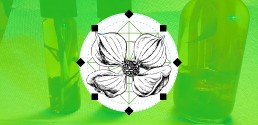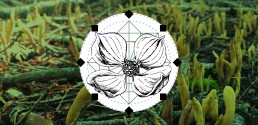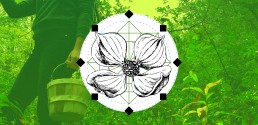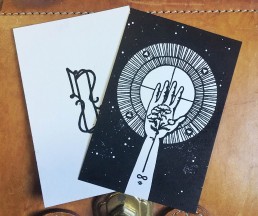Conversing with the Plants: Laurie Romano
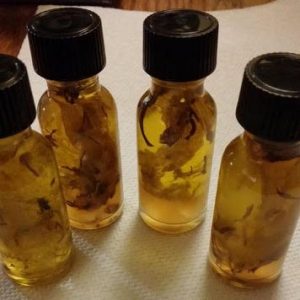 Oil magician extraordinaire Laurie Romano joins us today. Laurie is the Founder of Anubeion Creations. You can discover her work at https://anubeion.com
Oil magician extraordinaire Laurie Romano joins us today. Laurie is the Founder of Anubeion Creations. You can discover her work at https://anubeion.com
~
Casandra: Where did your journey making magical oils begin and how has that evolved?
Laurie: My journey making oils (and incense, sachet powders) began in 2014 shortly after undergoing initiation in a magical order. I've always loved perfumes, oils, and incense, and have used scent as an offering when working with spirits and deities for quite a while even before making them myself.
I began like many do, buying the products of others and working with them. I liked the products that had herbs and curios in them rather than just oil alone because they seemed more alive. I decided to start making my own when my wants became larger than my budget, growing curious about the process and magic involved in oil-making. Beginning with traditional hoodoo and traditional witchcraft formulas, I made a few and started using them myself. Here and there, I began sharing them with members of my magical order. To my surprise, they were a hit.
In my own work, I began to notice a difference when I used my own oils; this added to my confidence and I began spending funds on herbs, essential oils, and curios instead of buying anyone else's. I also started doing much more research on the plants themselves, feeling them reaching out to me as I worked with them. I began experimenting with the formulas, adding ingredients that spoke to me and that spirits advised me to work with; then took the step of making my own formulas. If I had a need, or a special goal in mind, I began to make my own products versus buying them from others. My awareness increased with experience and working with more candle magic, bottle spells, gris gris, and with my Patron god Anubis as well as the Archangel Raphael. More people began to hear about my oils and to request them when they needed something they couldn't find or when they wanted to have a connection with the person making their product.
Word of mouth slowly increased the number of inquiries I started to get about making oils, incense, and sachet powders, which grew outside the members of my magical order to the larger online magical community. While I hadn't initially thought of turning this into a business, it began to dawn on me in early 2016 that my work was growing in that direction. In mid 2016, I was asked by Aaron Leitch of Doc Solomon's Occult Curios if I would be interested in making planetary oils and other products for his site. This felt like a huge step, and it was the right one. We began expanding our respective product lines to include archangelic, deity, planetary intelligence, and other oils. In mid-2017 I put up a website for Anubeion Creations. This carried a few of the product lines on Doc Solomon's, but expanded upon the Ancient Egyptian deities and products that didn't really fit along the lines of traditional magic or witchcraft. It was here that I chose to dedicate the Work and the site to the Egyptian god Anubis, who has been the impetus for my life and survival. As time went on, more of my oils and incense began to come from commissions for custom work to serve a need that my clients had that couldn't be addressed by commercially available products, or a special need that they felt they didn't want to discuss with anyone else, or were unsure whether anyone could even make an oil or incense to use for their specific situation.
Since then I have had the honor and pleasure of serving a diverse community of practitioners from a wide variety of traditions, not all of them falling neatly into “magic.” Word of mouth and satisfied customers have slowly but surely expanded my customer base beyond anything I could have foreseen even a short while ago.
Some things have changed and some things have not. I still rely on word of mouth and do not pay to advertise. I have a highly interactive relationship with every client, whether this is from a website-generated order, a Facebook Messenger chat, or an email exchange; a practice I have had from the beginning and have no plans to discontinue. Most importantly, every oil, incense, or powder that I create is made to order for the specific client and their individual magical need. I don't carry an inventory to speak of, except for planetary oils (that require magical timing on the Waxing Moon for compounding and ritual planetary consecration). Every product is made by me by hand, using the client's name, goal, magical intention, and with guidance from spirits or deities. I do not and will not mass-produce my products. I also take pains to wildcraft the materia magica that I use, or obtain from sustainable sources; if these are from magical practitioners' businesses, so much the better. Perhaps the most important factor of all is that I continue my own Great Work, realizing that if I take care of that, the rest will follow.
I am grateful for every customer. Even when I am juggling a lot of things, when I have a customer, that customer and their needs are the most important thing I am doing at the moment. Little things matter. I find out what these things are, what matters to each customer. Instead of falling into a black hole when they place an order, I email every customer, thanking them for their order and letting them know when they can expect it to be shipped (and if I am delayed, they get that notification). When I ship, they get tracking information. I do what I say I'm going to do, and if there are changes, I have no problem making them. I pay attention to details and try my level best to meet expectations. If a customer has difficulty with certain plants or essences that result in sensitivity or allergy, in most cases I can work with them to make a product that is safe and enjoyable for them to use.
Finally, a certain percentage of oils, incense, and powder that I make is given to practitioners in need either for free, for a discounted rate, or for the cost of shipping alone. Sometimes I am told to do this by spirits or dieties, and other times it happens organically during conversations. I have done this from the beginning, and plan on continuing the practice. I've been very fortunate to be able to do what I do, but a large reason for this success is because I LISTEN. Listening to spirits and deities and being willing to give a struggling magical practitioner going through difficult times an oil or two, no questions asked, is very important. Sometimes I don't know the reason at the time, but believe that giving back even if I don't know why is still important. Service and helping others is especially important to the Egyptian, or Kemetic, deities as a part of upholding the cosmic, social, and individual obligations to the principle of Ma'at, and is a cornerstone of the relationship that I have with Anubis and the Netjer.
C: I love that you focus on small batches and take steps to make sure the products you’re preparing are sustainable. It also sounds like you put a lot of energy into planetary timing and ritual as they’re created. What is that process like?
L: Timing and ritual are the backbone of what I do preparing oils, incense, and powder. Timing, from a magical view, is very important. I work hard to plan certain things like planetary products with a Waxing Moon only, for example, and to do planetary products on the proper day and time of the week. Preparing a set of Mercury products on a Wednesday at the planetary hour of Mercury when the Moon is Waxing, followed by a planetary hexagram consecration ritual, is my standard practice. For the Waning Moon, making an Invisibility powder is a good thing, as the Moon is dark, and the energy is different. Creating a charm to make something or someone's influence over you diminish is also good Waning Moon work, even more interesting when the Moon is Void of course. When I want the assistance of a certain spirit or deity, I try and work on a day that is favorable to that entity as well. For custom oils, depending on what the customer wants, I will plan a specific date and time according to its astrological aspects, including the day of the week, and take the personal astrological information of the client into consideration.
That said, since I keep no inventory to speak of except for planetary products, there are times when I cannot get everything done within the Waxing Moon time period because I get more orders than I can reasonably complete in that short time. I also make each product specific and personal for the customer who orders it, when they order it, and I'm not about to tell customers that I can't do work when the Moon is Waning. There are also emergencies and urgent situations that come up when the planetary factors are not as favorable, but the customer is obviously not wanting to, they just want to solve a problem now.
Timing also applies to when I do or do not work. I do not make oils, incense, or powder in the morning unless the timing requires it and there's no alternative available (rare). Knowing one's self well enough to know peak energy levels at certain times and capitalizing on those times is important. I also don't work more than short stretches at a time because of the intense energy and focus that is required to do what I do, and I give myself days off regularly.
Ritual affects everything I do. For every oil, incense, and sachet powder or amulet I make, petitions and prayer are a part of it. I talk to the deities and gain their assistance. I primarily work with the Egyptian pantheon and Ancient Egyptian gods, so most of the actual creation process I have is based on Creation myths and the mythos associated with them (although I do work with others). I breathe life into each product to begin, talking to and petitioning the god or entity by name, and stating my intention. I then mention the name of the customer, their intent and purpose for the product I'm making, asking the god or spirit to assist them. With each ingredient I add, I state its purpose and repeat the intention of the oil/incense/powder I am creating. The process of speech, breath, intent, and focus (with my Third Eye, hands, eyes) results in Ensoulment; every product I make has Spirit, or Heka, or energy (this depends on the oil, the customer, and the intent) that can communicate with the customer once they receive it. I call stating the customer's name and their intent and purpose for the product “Naming.” I create the beginnings of a bond between the spirit created in the product, and the customer; I name the customer on the shipping label (another way of Naming) and once the customer receives it the bond is complete. A relationship is created, and is reinforced each time they use it. I have had customers tell me the oil/incense/powder instructed them on how to work with it. I've also accidentally dropped an oil, breaking the vial that held the spirit, and heard a shriek. There's so much more to making an oil, incense, or powder than merely mixing ingredients in a bottle or a mortar and pestle. Ensoulment and Naming go into everything I make, and everything I make is a living entity. I breathe life into it, create the beginning bond with the customer and the product, and make a relationship possible between them. The ingredients I use are not impersonal things; I ask their assistance and thank them for their sacrifice. They are part of the life force that becomes Spirit, Heka, and energy.
Magic is a personal art, after all. A magical act is a personal, spiritual and physical act that creates a ripple effect across dimensions. I create the oils, incense, and powder with the Egyptian Creation mythos in mind, becoming Cause; the customer begins the relationship and completes Effect. It is all very personal. I get to know everything I work with—whether that is the fresh plants, essential oils, or resins I use—forming a personal relationship with them as I create a new life with their union.
C: For those of us who are less familiar, what are the intended use of these oils?
L: The intended use of the oils/powders/incense depends. The Archangelic, Saint, and deity products are used to work directly with those entities, whether that is in ritual workings, offerings, devotional work, or in conjunction with another purpose such as a planetary working. Other purposes for the oils, powders and incense include protection, blessing, anointing, enhancing one's chances of prevailing in one particular situation or with business, enhancing one's luck, or improving the ritual work/ritual experience. Others assist a person in making work environments more harmonious or a boss easier to work with, and still others can be used to enhance the environment when writing one's doctoral dissertation. One customer that I have uses my products to support the environment when they are working with the dying. The needs and desires of the customer determine the use of the oils/incense/powders, and often I have received a request for a custom oil based on a need that a client has and cannot find an oil for. I have also made oils for a Golden Dawn Temple and offer custom oils for Temples, covens, groves, or other groups of magical practitioners, and have made oils or incense based on grimoires for Solomonic magical practice.
The oils, powders and incense that I make are not from one belief system or tradition, but several. They can be used by anyone, and one doesn't need to even consider themselves a magical practitioner to use them or gain benefits. “Magic” has mixed connotations in our culture, and sometimes it is better to keep one's individual practices discreet. There are those of us, however, that are quite open to calling it what it is and living openly as practitioners. Anubeion Creations works with those who are new to magic, those that have practiced for years, and those that do not call it “magic,” but “belief”—for those that work with spirits on a regular basis and for those that prefer to call them Saints.
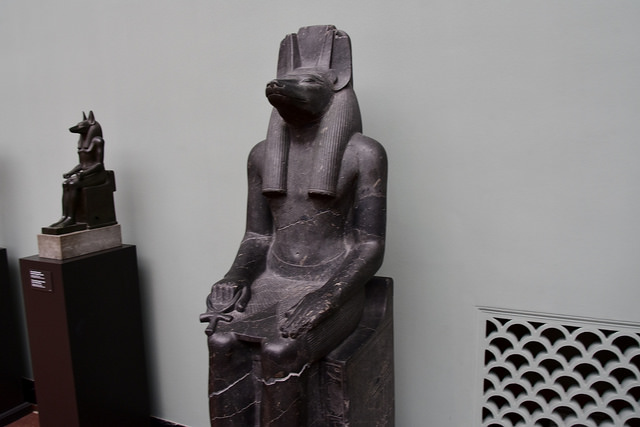
Anubeion's name is based on the name of an Ancient Egyptian god of embalming and the dead, Anubis, and the work is a devotional work to Him. The business and the site has an obviously Ancient Egyptian slant, but it is about Creation. In Ancient Egypt, “magic” was not separate from “religion,” and “magic” in the Western connotation did not exist as a separate theme until after Alexander the Great became king and the Greeks ruled Egypt. Anubeion Creations may use “magic” in its title for the customer who is looking for “magical” oils on the internet, but it is truly about Creation. In the Ancient Egyptian Creation myths that I mentioned above in the processes I use when I make products—specifically Ensoulment and Naming—are referring to bringing something into being. The myths refer to birth, life, death, and rebirth. Anubeion Creations is dedicated to this, and the products can be used in any of these situations. Whether one does daily ritual practice or just uses an oil to improve their confidence, Anubeion Creations can meet most needs. If there is a need that cannot be met, Anubeion can make a suitable referral or suggestion with other practitioners in the magical community.
The uses of oils, incense, and powders are not limited to that which I have outlined above. The creative practitioner or client can discover additional uses depending on their relationship with the oil, incense, or powder. It is all about relationships, whether these are relationships with spirits of plants or deities, or with the discovery of how these energies relate to each other or how they manifest by our direction.
C: How do you learn which plants should be involved with particular oils? Have you developed a relationship with or deeper understanding about those plants along the way?
L: I have done, and still do, much research on the ingredients of the plants and curios I work with. What began as studying the formulas and products of others and seeing if I could do the same, has branched out to making my own formulas. Depending on the product I am making, I'll begin with plants, stones, and other correspondences as a starting point, including zodiacal and traditional lore and/or traditional religious or pantheon lore. I refer to grimoires, sacred texts, and even academic journal sources, as well as reputable web sources, experienced practitioners, and published sources. I'm a mixture of an observer of traditional lore (hoodoo formulas, which have a group of plants and curios for a given purpose that are considered traditional), science (botany, entheology), and the information I gain from the spirits I work with. At times, I can be in the middle of creating something, and I'll get a whisper in my ear saying, try this, or leave that out.
Perhaps the most important thing to state at this point, is that it is important to have knowledge of and respect for traditional lore, but also to be open to reading scientific and academic material. Some in the magical community think it has to be one way or another, or follow strictly their own personal gnosis. I disagree. I follow all threads, and will do research if I am unfamiliar with a plant or if I am unsure of how something will work with another plant, essential oil, or curio. I believe strongly in continuing education, growing my knowledge base and grounding that firmly in practice. By “practice” I mean being open to listening, whether that is letting the spirits of plants speak to me, listening to the spirits and deities that I work with, or in my personal spiritual practice and ritual that I do on a daily basis. Lastly, I am not strictly an academic, but I do think being able to study the science and read the academic literature adds an important dimension to my work in that this type of knowledge rounds out the other sources of knowledge that originate in sources which are more difficult to verify. Being able to research and understand chemical components of plants and their species also assists me in working with them in a more sustainable, cohesive, and respectful manner.
To do this Work, to create what I create, means that I continue to learn and grow; I grow in knowledge and experience by study, education, and practice. With every oil, powder, or incense I create, I learn a little more and develop deeper relationships with the plants and materials I work with. I let them teach me, I let the spirits teach me, I hear it on the wind and the unseen realms. I pick up a book or go to a scientific website to read about a plant or species of plants. It is impossible to not develop deeper relationships or understandings if one does this work for any length of time. The Ancient Egyptian Creation mythos is not about one Creation event, it is about Creation on a continuum, on a nonlinear basis; this lends itself well to continuous development of knowledge and experience. Magic is Art, Science, Philosophy, and Practice—which also fits in well with my understanding of the mythos.
The reader will notice that I ground the Work I do as Anubeion Creations in ancient beliefs, and this is intentional. This is the “secret sauce,” if you will, that makes Anubeion Creations what it is. This is why I don't mass-produce my products, why I care about sustainably sourced plants and other materials, why I care about small batches, the magic involved with the Ensoulment and Naming, why I rely on word of mouth instead of paid advertising, and why I make all of it a spiritual process. If work loses its spirituality and its connectedness, it becomes task-oriented and loses its soul. I cannot think of a more horrible way to live than performing meaningless tasks for a goal that has no soul, no purpose, and is anathema to living in harmony with Creation.
C: Is there a particular plant of oil that you identify or work with most?
L: Because of the diversity of the oils/incense/powders that Anubeion Creations makes, there isn't one particular plant that I work with that I prefer over others. I do, however, have my favorites. I work with a variety of Frankincense resins such as Carterii, Royal Green Hojari, Coptic Frankincense, Dalezii, and Boswellia. I purchase these from Dan Riegler at Apothecary's Garden and Jeremy Bechelli at Phytognosis, as both of these sources are knowledgeable about these resins and obtain them sustainably. I also like working with Yarrow—both the plant and the essential oil—for its versatility and the flexibility of movement that I have learned a bit from continuous work with it. Another resin and oil I like to work with is Opopanox, which is in the Myrrh family. It is most commonly found in my oil and incense blends to honor Anubis (based on His mythology and tradition) but also as a key ingredient in my Morpheus Flying and Dream oil. I also like using Devil's Shoestring root in oils and powders such as XXX Triple Strength Algier's Luck Oil, Kyphi oil, Crown of Success, and in other blends where I want to lend a boost of strength or with a powder titled Hex Breaker for the purpose of “hobbling” or hampering the efforts of a hex made against the client. It is also incredibly versatile. While having traditional lore from hoodoo magic sources, it is not limited in its applicability. Lastly, I also enjoy working with Solar natured plants (see Frankincense above), and with almost any flowers, with a few favorites like Rose and Jasmine. Some of the flowers have also found themselves in a Mason jar with 80 proof Ciroc vodka for tincture. Those tinctures are used in some of the Archangelic oils I make.
Lately, I have also begun a relationship with plants such as Belladonna, Henbane, Datura, and Mandrake, which in turn have found their way into products such as Spirit Summoning incense, Love Potion 1 and 2, and Morpheus Flying and Dream Oil. Soon I will be producing a Flying Ointment in cooperation with Doc Solomon's Occult Curios, but that is secret for now.
C: Tell me about your custom oils. What types of things do people come to you needing and what is your process?
L: The process begins with a client asking me questions and inquiring if an oil can be made to serve a particular need, or to enable them to work with a specific spirit or deity, or to serve a specific purpose. I question them extensively about what they want to create, how they want it to manifest, what type of relationship they either already have or want to have with the spirit or deity, etc. I ask whether they have had any dreams in which they have received instructions, whether they have done divination on the matter or potential outcomes, whether they have special prayers or special herbs they want to be included, and anything else they feel I should know. Sometimes I will do a divination with the client to come up with a list of herbs or curios to be included. Other times I already have an idea of a few herbs or curios to make the outlines of a formula. I'll ascertain if this will be used with other magical means such as candle magic, part of an evocation or other ritual work, or with other spirits. If this is for a specific purpose, such as a need for protection, I'll question what is happening in detail, including the place where spirits tend to show up or the situation that seems to be the origin of the problem. I’ll ask what measures they have taken to deal with it and what the results were. I do not do magical work for clients, but I will instruct them how to use products that I make. Most of the time people have varying levels of experience and have a plan for a custom product that I can, hopefully, make them. We discuss these plans.
At this point I give a quote and discuss what I have come up with in terms of a formula and how that might work. I communicate with the client and invite them to keep me informed of any dreams or spirit communications or additional divinations that might impact the work they’ve hired me to do. The process of creating the oil or incense or powder is similar to what I've discussed above, including research on the spirit/deity or specific herbs I may need to know a bit more about for the purpose of the custom product. After they receive and work with their oil/incense/powder, I'll usually hear back about how things went and if their issues were resolved. This is very important information for me, and fortunately I have recieved great reviews that tell me things were resolved or the oil was ideal for their needs.
Listening is doubly important here. It is about what the client states their needs are, what they want to be able to do with the oil, and the issues that they expect the oil to assist them with. All knowledge is good to have, especially with custom work. Good communication is critical, all the way from the inquiry phase, through the creative process, and most importantly, the outcome.
Hearing from clients that I was able to get it right is Priceless.
C: What’s the most interesting custom oil you’ve ever been asked to make and why?
L: One of the most memorable custom oils I've created was for a client that is a regular customer and long-time practitioner. He wanted an oil to embody a deity featured on a specific tarot card. He described the deity as Thoth the Magus and discussed his understanding of the deity gleaned from previous Work. We communicated a few times, discussing impressions, herbs that he has used to work with this god, and the understanding he has gained from the god about its nature. I shared a few herbs that I had in mind from my own previous work with this particular god, and he replied that he trusted my judgment. I then wrote these few herbs down as a skeletal formula and let things gel over a few days. I was able to add a few additional ingredients and a few possible curios, and then set out to make the oil. I asked for Thoth's assistance, and was told to make a larger bottle than I'd planned initially. I then added an Ibis feather, which is a form of Him. After that I was told to add a dried python skin, in as close to a form resembling a caduceus as I could manage. I then began to add the carrier oil, organic almond oil, for its lightness and ability to balance ingredients. The Elements of Air, Light, and Spirit, with Mercurial aspects of movement and flexibility, were predominant in this formula. I felt the presence and received the guidance of Thoth as I added ingredients, one at a time, in a special order. When I do this, I will test the scent; usually the deity or spirit will tell me when it is right, and most of the time it smells/feels right to me as well (sometimes that’s not the case, but I listen to the spirit). I finished, and the oil was just awesome. The python skin gleamed brightly in a DNA spiral shape, accenting the Ibis feather and centering a strong bolt of energy. The Elements, Light, and Mercurial aspects were perfectly balanced and complemented the visual effects. It was just gorgeous.
My customer messaged me when he received this oil, telling me, “It is so stunning that I almost cried when I saw it.”
That is one incentive of doing what I do. I set the conditions for a client to have that special relationship with a one-of-a-kind oil. Hearing from clients that I exceeded their expectations is one thing—awesome! Having clients tell me that I am their go to person for all their oils, having repeat business from them, having them tell me that in all the years they've practiced, they have never seen or worked with oils like mine, that they will tell everyone they know about me and send them my way for oils—that is beyond anything I could have foreseen. It makes the trials, tribulations, doubts, and fears about doing what I do truly worth it.
My client has kept his promise, as I now have so many orders that I’m booked four weeks out.
I now have more interest, more inquiries, and more contacts to go with the increase in orders than I could have foreseen even a few months ago.
Just like I did when I started, I Create. I Birth. I Unite. I Ensoul. I Name. I make relationships possible.
~
If you loved getting to know her, you may support Laurie's work here.
Conversing with the Plants: Jason Scott "fixing the celestial wanderers," or the alchemy of the Fungal queendom
 Jason Scott, mycologist, alchemist, artist, joins us today. Jay is the curator of Alchemycology.com and his active in the Radical Mycology. He runs Feral Fungi and is primarily focused on the interrelationships between alchemy and mycology. Without further ado, let's hear what he has to day:
Jason Scott, mycologist, alchemist, artist, joins us today. Jay is the curator of Alchemycology.com and his active in the Radical Mycology. He runs Feral Fungi and is primarily focused on the interrelationships between alchemy and mycology. Without further ado, let's hear what he has to day:
~
Casandra: Tell me how you got started with alchemy…
Jay: My journey into alchemy was the summation of a number of synchronicities in my life that began before I really even knew what alchemy was in the practical sense that I understand it now. That journey started with a departure from a standard path to go to Hawaii and study natural medicine and cultural relationship to plants and the land. While I was there I experienced a lot and really dove into my personal relationships with plants. One plant in particular brought me to Pahoa and I was given some primary texts on alchemy and Ayurveda that really piqued my interest, including Real Alchemy by one of my favorite teachers Robert Bartlett.
When I returned from Hawaii, I found an intro into herbal alchemy class in Portland and at the end of the class the teacher shared that they had just gotten back from studying with Robert Bartlett in Washington, which motivated me to begin studying with one of the greatest alchemists of our time and one of the most humble teachers I have had.
C: And when did mushrooms begin taking center stage in your work?
J: While I was studying alchemy, the philosophy and principles really resonated with me, and I was mostly focused on getting a solid foundation in the herbal works. Mushrooms have always fascinated me in a number of ways, especially their potential as medicine, so I was curious where they fit into the tradition of alchemy. I discussed this with Robert Bartlett to see if he had any leads or insights. I also pondered some of the claims of the fungi being the philosophers stone, though from my understanding that was something practically completely different than anything in or dealing with the organic realm, and most likely metallic based.
To my own mind I saw mushrooms and queendom Fungi as somewhere in between the plant realm and the animal realm, as they are more closely related to animals on the tree of life and very different morphologically from plants as well. This led me down a path of experimentation and thought in working within the philosophy, principles, and practicum of alchemy as I understood it relating to other realms (mineral, plant, and animal) and to apply it specifically to the fungi. This has been a long and slow process and still has a long way to go, but it gave me the motivation to develop a unique way of working with and seeing the fungi, specifically through the lens of Hermeticism and alchemy.
It also gave me the motivation to look at the queendom Fungi as a whole and the way they fit into the philosophical underpinnings of alchemy and the parallels that exist between the two worlds. Both have so much to offer us in our understanding of reality and our relation to the natural world.
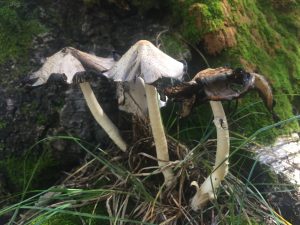 C: What are some of your biggest inspirations and why?
C: What are some of your biggest inspirations and why?
J: I’d have to say nature in general, as my understanding and experience of alchemy is that it is all based in observation of natural processes and mimicry of those things, witnessing patterns of life and death, and everything in between. I obviously have to give it up to the fungi here too, for all they offer us in terms of healing ourselves and the land, in the lessons they teach us about life and death and reality, and in the ways they function within the ecosystem as connecting everything. They are really like the perennial philosophy of the natural world, as alchemy and many other traditions are to our world and understanding.
I have also had a strong connection with shamanic traditions and cultures and how those influence the way we perceive and move through the world. To me, they parallel the alchemical traditions, and in certain instances they are still alive and have never been broken in the same way that alchemy was to the west. I think that working with the perennial philosophies of both these worlds has a lot to offer us in relation to ourselves and to the world.
As far as people go, Kathleen Harrison was a large influence in my dive into natural medicine and cultural relationships to plants, or ethnobotany. Robert Bartlett really gave me a strong foundation in the art and a supportive place to practice and ask questions and to further develop my work. My good friends and fellow spagyricists Sajah and Whitney Popham, in the way they work with and connect to the plants; Peter McCoy, for the opportunities he has given me and the faith he has in my path and projects as well as all the good work he does with the fungi locally and globally. There are really too many to list, but there are a few who have been instrumental to my growth and exposure. Also Jenn Zahrt, Catamara Rosarium, and Marcus McCoy for their support of my work and giving me a platform to share and express my thoughts and research.
C: Tell me about one of your most exciting/scary/harrowing/unexpected experiences in your journeys of talisman-making and alchemy?
J: I don’t know that I have any specific instances I’d care to share here, but it really is interesting watching people and seeing the different energies and archetypes move through them, especially when they call those things in. Really makes the journey a lot more real and to recognize the patterns and see them come alive in people and through the medicine.
C: You've created some very fascinating correspondences between various species of fungi and astrological influences. Tell me about how you got started on that work and where you see it leading? What do you sense the relationships are between this class of organisms and the stars?
J: I was really intrigued to find that fungi, which have always fascinated me, were almost completely neglected in any of the traditional texts. You will find that a lot of plants, especially common ones in Europe, have traditional planetary correspondences. That just does not exist for fungi. One of my favorite parts of the Work is looking at the different levels of the archetypes – planetary, elemental, principles – and seeing the way those patterns reflect in nature. It is said that when something dies, it returns to the sphere on the Sephiroth from which it came, and each sphere is associated with a different planet, so that thing returns to that archetypal ring when it ‘gives up the ghost’ as they say.
This correspondence is instrumental to alchemy especially when working with spagyrics and creating the initiatic medicines that align the mind, body, and spirit through the work, but also imbibing the tincture. So when working with the fungi, or herbs or metals, your still acts like a microcosm of the universe and you can capture different planetary energies and bring them into the medicines that you are making, especially if you dial in more specific timing, but you can also just go by the day of the week and the planetary hour of the day.
For me this became a fun exploration as I began looking into the fungi and realized they didn’t have any traditional correspondences. I made a central part of my work looking at the archetypes of the planets and the specific morphology, qualities, and actions of different fungi in order to make correspondences. As I found the mushrooms are very complex and tricky, so I laid my work as a foundation and share it as an opportunity for people to delve deeper and to create their own correspondences for the personal work.
It also seems that working specific planets into the work helps to illuminate different properties and qualities that one wishes to draw out more. I also found it really interesting that ‘planet’ means celestial wanderer and that ‘plant’ means to fix, so I look at plants as ‘fixing the celestial wanderers’ and tend to draw that same associations to the mushrooms in that way.
I am hoping this work lays a foundation for working with and seeing more fungi in this way, as I think it tends to add another layer of understanding to the ways we see and work with fungi. It is also just a fun thought experiment to become more familiar with the planetary archetypes and the actions and functions of the mushrooms.
C: Why do you think that alchemy neglected the fungal queendom for so long?
J: I think it just kind of goes along with the fungal phobia that has been a part of many cultures over time, they really represent death, and in that sense weren’t thought to be suitable for human consumption. It’s really fascinating because it seems like the work of the Fungi parallels that of the alchemist and that they would compliment each other very well. I am still hoping that at some point I will stumble across some ancient text that reveals all of the things I have been looking for and working on.
C: Tell me more about your work in Nepal. How did that get started and what are some of the things you have experienced there? What are you hoping to preserve and/or change?
J: So I had this amazing opportunity to go to Nepal with Todd Caldecott of the Dogwood School of Botanical Medicine and to meet one of his teachers over there, Madhu Bajra Bajracharya who is a part of a lineage that goes back over 750 years. More specifically the lineage of Ayurveda is the Rasa Shastra lineage which deals with metals and minerals as medicine, and really mirrors western alchemy in a lot of different ways. So while I was there I got to see Madhu practice in his clinic and share some of the traditional clinical wisdom that they have around helping people. We also got to learn how to prepare some of their traditional medicines including some of the mineral medicines that they work with.
Vaidya Madhu’s father Vaidya Mana had a vision of creating a clinic in Nepal to preserve their traditional wisdom in practicing clinically and preparing traditional medicines. They also have a handful of texts from their family in various disciplines of Ayurveda that are all in Sanskrit, written on Palm leaves, and we hope to help them keep those manuscripts in Nepal.
Todd wanted to help fulfill that vision, and it really moved me too so I decided to jump on to help them as well. At this point Todd and I are working out the beginning stages of finding funding for the project so we can build a center over there to train Ayurvedic physicians and to purchase the manuscripts from the Bajracharya family so we can keep them in Nepal and make them available for scholars of Sanskrit and students of Ayurveda.
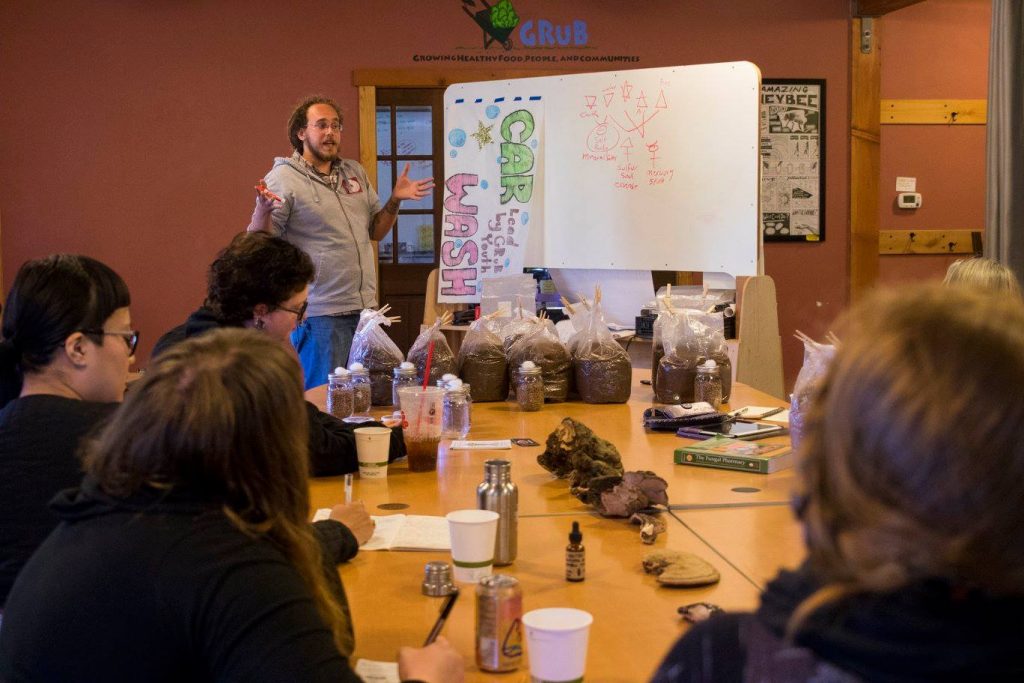
C: How do you see yourself as different from other people who do what you do?
J: I am just persevering and trying to do good work and support these amazing systems of traditional medicine that I have had the opportunity to explore and the amazing teachers who have shown me good things along the way. I think there is so much incredible wisdom that would be a shame to lose it to the sands of time. So primarily I want to support that and see it flourish in a good way, and see the people who are perpetuating it flourish in a good way, too.
That said, I am not trying to get too far ahead of myself. I see myself as a lifelong student with a lot to learn, yet I also believe that I am carving out a unique path with the mushroom work and intend to move forward in that way. I have been told that I am really pioneering a field in that regard, but I also just try to remember where I am coming from and to stay in service to the Fungi and the Tradition, and all of the other medicines and ways that have helped me get to this point.
I am looking forward to watching this work blossom in the future as it has grown so much since I began.
C: What challenges have you had to overcome to get where you are today?
J: I think mostly overcoming self-doubt and believing in myself and in the medicine, and recognizing my place in service to those things and then just trusting the journey. It has been strange being so deeply involved in not one but two fringe topics and kind of bridging the gap between the world of mycology and the world of alchemy. It is fun and challenging, especially just relating these things that I am studying and know and having to repeat them to people who know one part, or people who know the other, or most of the time people who know nothing about either. In that regard it is kind of fun too, and really nourishing when people are really interested and supportive.
The other hardest part is figuring out all of the ins and outs of working all of these good things into a business too and making them into something that I can sustain myself with as well as offer in a really good way.
C: Where do you see yourself five/ten years from now?
J: Hopefully continuing these works and having at least a primary book finished by then, elaborating some of the ideas I have been sharing and teaching, as well as some more solid research into some of the theories and types of extractions I have worked on and created. I also hope to deepen my medicine practices and to offer consultations to people, which I am really ready to start now, but I hope to apply all of those things and offer them in a good way to all of the people who need help, especially in interpersonal work and trauma.
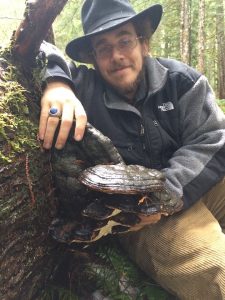
C: What is your theory of change in the world? (How do we get things to be different/better?)
J: Oh man, that is a big question, and really instrumental to the path that I am on. I initially began that path externally by trying to change external systems, which do need a lot of change, But then I realized how much internal work needs to be done first and found that these paths lead to that internal shift and wisdom that I think a lot of different people need. I feel like we are culturally addressing some really deep traumas and that those things lead to the conditional patterning that we see expressing themselves in really toxic ways. I think that all different pathways are necessary to address that change and have found my ‘revolutionary’ or ‘evolutionary’ work to be through the medicine and sharing and working with it to help people in that way, as well as all of the physical ailments they deal with that are sometimes connected to that as well.
Another element that gets frequently overlooked are the spiritual afflictions which I feel are at the root of a lot of the cultural trauma that we experience, and I think there could be a lot of benefit in looking at those areas and addressing them through different means. I think the plants and fungi play a crucial role in this part of the equation, and I personally have learned a lot from them and hope to continue to grow in that wisdom and hope to share it as well.
C: Thanks, Jay! We look forward to more of your writing and research about the alchemy of the fungal queendom and more original artwork from you.
~
If you would like to see more of Jay Scott’s work, see his spagyric business FeralFungi and his contribution to Verdant Gnosis 3, titled “AlcheMycology: Applying Alchemical Principles to the Fungal Queendom” as well as his work with Radical Mycology.
Conversing with the Plants: Becky Beyer on foraging, folk magic, and more
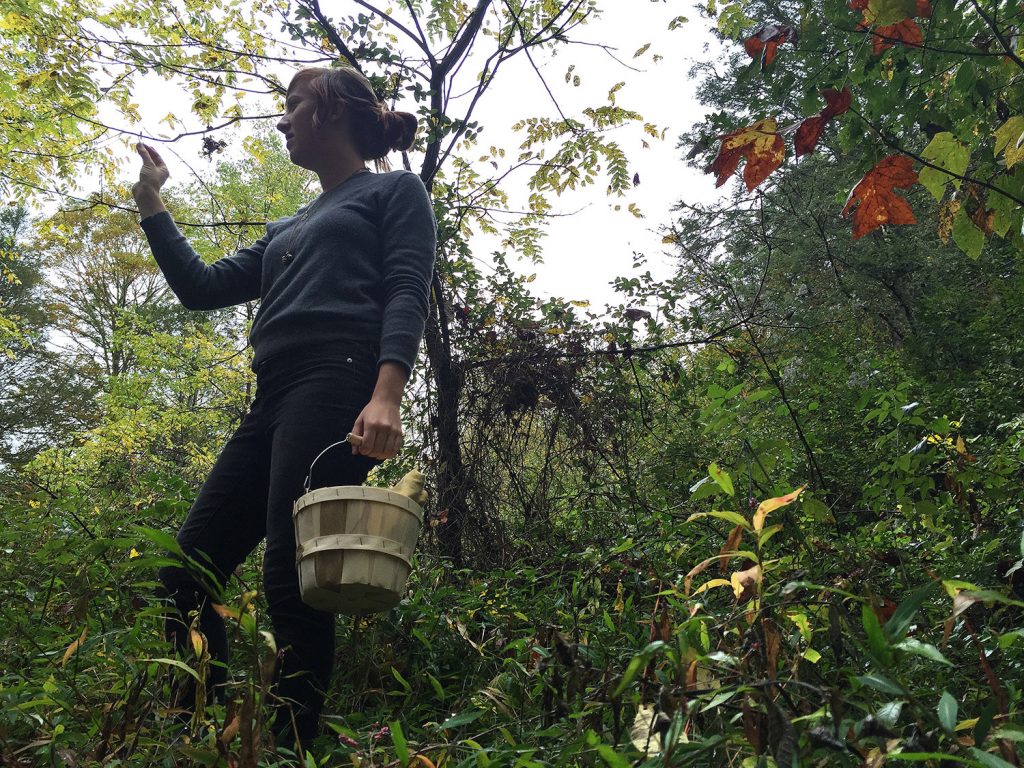
~
Meet Becky Beyer, is a farmer, woodcarver, herbalist, witch, and illustrator from Asheville, NC. I met her at Viridis Genii Symposium last year, where she both spoke and played in her musical group Kith and Kin. Becky bridges the worlds between academia (working towards her PhD in Ethnobotany) and Appalachia (teaching in the Primitive Skills community for the last five years). In this interview we discuss her various pursuits and passions in the world of plantlore.
~
Casandra: Thanks for taking the time to talk, Becky. I was happy to hear you present at the Viridis Genii Symposium last year and really impressed by your ability to weave together academic discourse, folk tradition, and personal experience. How did your relationship with the plants begin? Was there an experience that initially impacted you?
Becky: I think for me my relationship with plants began when I got sick with chronic mono—well, that’s what I called it. I had terrible fatigue and a hacking cough for almost a year. I saw six different doctors and they all just didn’t know what to do with me. I ended up visiting a local herb store in Vermont where I was living at the time and the woman there gave me goldenseal, thyme, and boneset. I drank these as a tea for three days, and my cough went away. After a year of struggling with it, I was in tears with joy. I realized then the incredible power of plants, and I started studying them right away. I changed my major in college from Medieval Studies to Plant and Soil Science. It radically shifted my life path.
C: I love hearing stories about the healing capacity of plants; it sounds like that really altered your course! We all relate to the world around us in unique ways; what does relating to plants look like for you?
B: For me relating to plants is my living, my passion, and my obsession. I do not relate to plants in the same way as a lot of my colleagues and peers, but I eat wild plants and plants that I grow everyday, and I make my living from them. I am a professional forager and teach people how to forage as my day job. I also sell my art as a botanical illustrator and teach ethnobotany at a local college. I have a spiritual practice that centers around certain plants, but there are other plants that I eat everyday or work with everyday. We have moved into old-friend territory. Rather than making offerings and much ceremony over every plant I pick, I have moved into a relationship where large cyclical offerings have taken the place of that practice. I wonder what my ancestors would have done; the practice of seasonal devotion is the best guess I have.
C: We each have different qualities and types of relationships with the people in our lives. Do you find this to be true with plants as well? Is there a plant that you work with and relate to in a particularly poignant way?
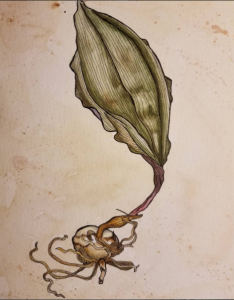
B: I have a handful of plants that excite me and call to me. I love my local Appalachian flora and their incredible histories and magics, specifically Pokeroot, Mayapple, and Sassafras. They are uniquely native, food, medicine, poison, and magic. I love that intersection of “what can cure can also kill” as well as the historical importance of these plants to Native peoples, hoodoo practitioners, and Appalachian folk practitioners.
C: I’m really curious about Appalachian plants specifically and the history of tending stands of wild plants, as well as the songs that folks in that bioregion use in their practice.
B: Growing and tending wild plants here in Appalachia is a complicated thing. Appalachians are used to conversely being romanticized and stereotyped as people who are both in touch with the land, and wanton destructors of nature in reference to mountain top removal and logging. It’s tough. We have incredible local folks with intact knowledge of the uses of hundreds of plants, and those whose only access to resources for making a living is by exploiting the environment.
Ginseng is the biggest cash crop from these mountains other than timber, and the way most people harvest it is to just take every single root they can find. Certain people tend stands on their land only to have them stolen in the night. Others protect certain areas for years only to pass away and have relatives remove all the plants. However, many people grow and cultivate wild plants or tend existing stands regardless.
As far as songs go, we have a lot of traditional songs here for working, but not many specific to picking wild plants. I am sure many people have family songs that were passed down that people sing as they foraged, but because not many do anymore, it’s hard to say. We are creating new traditions and songs for plants; hopefully someday we’ll get around to recording them to share with everyone. As a person of British Isle ancestry, I use the Carmina Gadelica for magical inspiration, and I’ve used the Yarrow charm and others to sing to the plants while I make their medicine. Here is the Yarrow Charm gathered in 1900 in Scots Gaelic:
I WILL pluck the yarrow fair,
That more benign shall be my face,
That more warm shall be my lips,
That more chaste shall be my speech,
Be my speech the beams of the sun,
Be my lips the sap of the strawberry.
May I be an isle in the sea,
May I be a hill on the shore,
May I be a star in waning of the moon,
May I be a staff to the weak,
Wound can I every man,
Wound can no man me.
C: That’s beautiful, thank you for sharing it. We are doing work here in the Northwest to create new traditions around plants and music as well; it seems like such an important aspect of those relationships. How do the plants influence your work as a magical practitioner and teacher?
B: Plants are the backbone of my practice and my work. Sharing and learning their histories and stories is my bread and butter, most literally. I like to focus my teaching about foraging and crafting on how to really work with a plant from a holistic perspective. Plants influence me with their bizarre actions, magical effects, and intoxicating dreamscapes. I work with them by eating them, using them for medicine, and often just by being in their presence or using their energy to aid in a working or make a charm. In Appalachian folk medicine and magic, sometimes just having the plant around, whether around your doorway or in a sachet, is enough to draw on its power. This is how I operate in their realm, and I am always listening, waiting for further instruction.
C: Do you have any advice or favorite resources to share with folks who are perhaps just beginning their work with plants on this relational level?
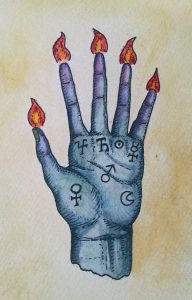
B: I would recommend my site, Appalachian Ethnobotany. It is a living database of resources on all kinds of plant uses and lore. I just added a folk magic section as well. This is a good place to start. Also, if you are not in Appalachia, reach out to local herbalists, older folks, primitive skills instructors, or anyone else deeply rooted in your bioregion. These are the people to learn from!
C: Well Becky, thank you so much for your time. I love the work you are doing—your art especially—and hope to continue seeing more of it in the herbal, magical, and rewilding circles.
~
If you want to learn more about Becky’s work, writing, music, and magic, check out her article in Verdant Gnosis Vol. 3 on Pokeroot, Mayapple, and Sassafras, as well as her Appalachian Ethnobotany site and her blog www.bloodandspicebush.com.
Also, the Viridis Genii Symposium, where I met Becky, is accepting submissions for their 4th annual event. Make sure to apply by November 28, 2017.
http://www.viridisgenii.com/presenter-proposals/
Talking plants and publishing with Casandra Johns
Casandra Johns, a dynamic editor, publisher, herbalist, print artist extraordinaire is joining the Revelore editorial team. Johns, of Oregon, is the creator of House of Hands, her own press and book arts operation, which has a few titles to its credit and a series of handbound books. She took some time out of her busy schedule to talk with our founder Jenn Zahrt about how she got into publishing, what she’s up to at House of Hands, and where she sees herself going!
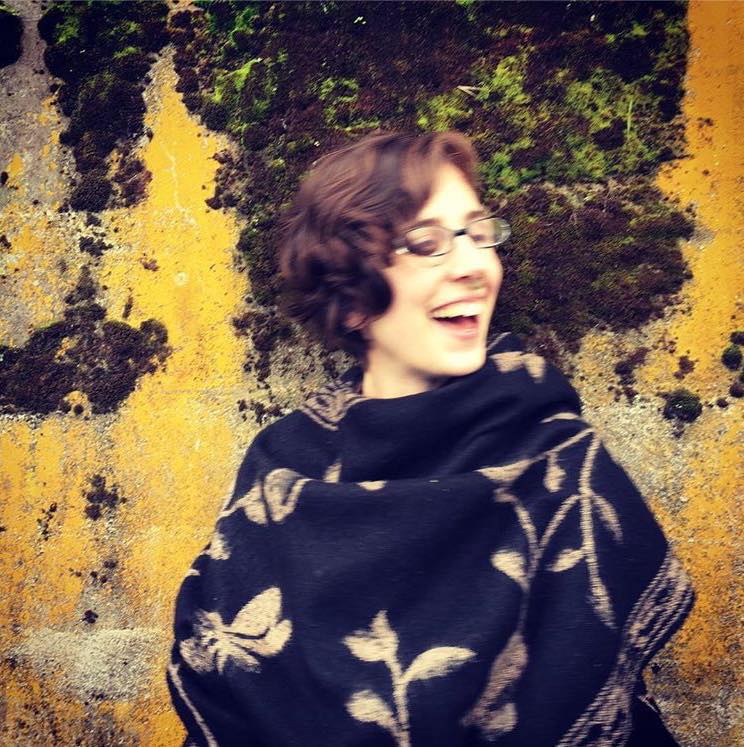
JZ: Casandra! Thanks for taking the time to share your world with me. I know you have a background in herbalism. I’m curious as to how you landed in the world of publishing?Read more

